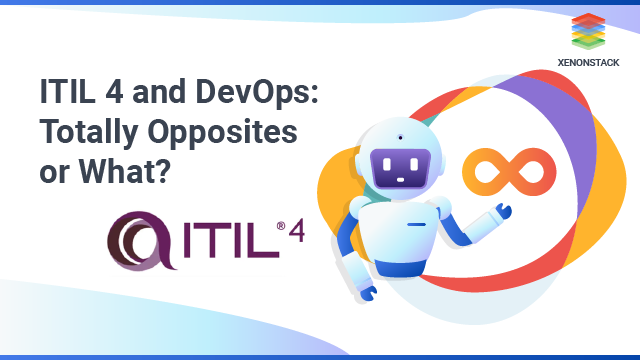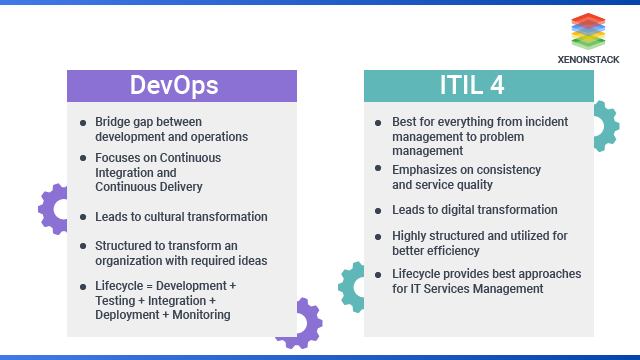
ITIL and DevOps: A Quick Overview
While following the stages of development of software, a new question comes to mind, and that can run together for the improvement of any process and how ITIL provides us with a field to work with Virtualization in DevOps. Well, if you are searching for the answer to the same questions, do not worry as we have developed this technical guide. Here we will show you the real difference between both and how to use both for agile development. So, let’s get started!ITIL vs DevOps: What’s the Difference?
ITIL is a framework, and it was developed with a collection of practices to implement the most reliable IT Service Management. Its structure is created to highlight service conditions and flexibility, set the service life-cycle, aim for more special customer comfort, and push digital modification. Whereas DevOps is a set of concepts that appear from the impact of two influential aims. The first was called "agile methods" and the second was an extended perception of the amount of collaboration between development and operations staff. When talking about Both, DevOps essentially concentrate on Combining software testing, software development, Quality Analysis, and deployment platform, Continuous integration, and continuous delivery. DevOps Automation Tools operate in sets and move agile to have a faster turnaround interval.
What Happens When We Integrate ITIL with DevOps?
Both of them are quite different intentions that carry out the real beauty of service administration. ITIL contains a lot of the core importance discovered in frameworks including Lean, and Agile in DevOps. Ideas such as covering value, raising collaboration, and utilizing what it defines as a four-dimension model make a holistic way to service administration. With its cooperation, we can streamline the whole service administration method while DevOps leverages service delivery by inducing appropriate teams collectively and automating conventional tasks to be agile. the methods establish clear tasks and liabilities, whereas DevOps resolves the query of expression and information. It is the Service Management framework, that gives care for products and services that are being developed and expanded using DevOps methods.Working Principles of ITIL
A guiding principle accommodates worldly and permanent guidance to a business, which fits in all states of using both. The 7 Guiding Principles are an arrangement of the 9 Guiding Principles established in 2016’s Practitioner program.1. Focus on Value
- When concentrating on value, the first action is to know who the customers and important stakeholders are being served.
- Next, we need to have a clear knowledge of what develops value from the consumer’s aspect.
- Lastly, we have to take care of the customer experience or user experience.
2. Start where you are
- Do not start over without thinking about what is already available to be leveraged.
- Co-operation and programs already in place should be recognized immediately to correctly interpret their current state.
3. Progress Iteratively with Feedback
- We were exploring and accepting feedback from ITIL and DevOps before, and later each iteration will ensure that operations are directed and relevant, even in different situations.
- Once accepted, feedback can be examined to recognize development possibilities, hazards, and problems. We have to take care of things such as the ecosystem is regularly changing, so feedback is required, and Quick does not mean unfinished.
4. Collaborate and Promote Visibility
Formation is usually a better strategy than separation. Inventive solutions inspire participation, and critical views can be obtained from unexpected sources. But the most important step is operating ITIL and DevOps collectively in a manner that leads to success and asks for knowledge, opinion, and belief. When stakeholders have a bad perception of the workload and improvement of the task, there is a risk of forming the impression that the task is not superior. So we have to consider points like:- The report in a way the observers can hear
- Choices can only be made on obvious data
- Collaboration does not mean agreement
4. Think and Work Holistically
A holistic approach to service administration covers building a perception of how all parts of the industry serve unitedly in a unified manner, including having end-to-end clarity of how a request is taken and interpreted into results. So, to follow this principle, we will understand the complexity of ITIL and DevOps systems, and look for models in the demands of and communications between system elements. Also, you must know the best practices for Enterprise DevOps.5. Keep it Simple and Practical
Use the least quantity of actions to achieve an objective. An outcome-based study should be practiced to provide practical solutions that produce helpful results. If a method, service, activity, or metric fails to produce value or provide a valuable outcome, then drop it and to do so consider some points like secure value. Primitiveness is the ultimate elegance, Do fewer tasks, but perform them better.6. Optimize and Automate
Optimization intends to produce something as effective and helpful as it needs to be. Before an action over both methods can be efficiently automated, it should be optimized to whatever feasible and reasonable level. There are several methods in which practices and services can be optimized, and to follow those we understand and click on the context in which the intended optimization exists, concentrate on simplification and value, and ensure the optimization has the proper level of stakeholder commitment.ITIL is a set of best practices for delivering IT services to your customers. It has its roots in the IT world, but its principles can be simply used.
Agile Manifesto and ITlL Working Principles
- It has concentrated on Continual Growth and recommends that everyone in the company should focus on constant progress in every level of activities.
- It insists on achieving enhancements to existing products and assistance, and execution of digital transmutation schemes.
- Wherein new administrations and technologies would be developed and executed.
Benefits of ITIL DevOps integration
It is now aligned with Agile and DevOps. So, here are some of the benefits:- Both are principally centered on how an association builds value in or as a service and improves customer comfort with continuous progression.
- Resolving concerns accurately under a structured framework guides building agile solutions for complex problems.
- Enhanced productivity and constant improvement complete the organizational goal of making more active Returns on investments.
- Both open-source tools provide magnified execution and improved overall business efficiency.
.webp?width=1921&height=622&name=usecase-banner%20(1).webp)


